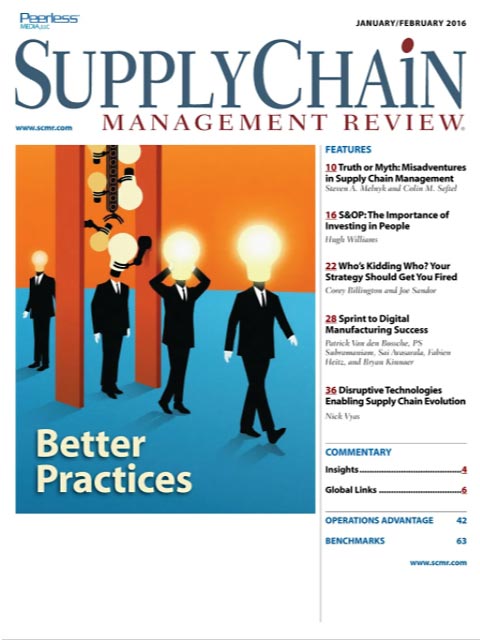Sorry, but your login has failed. Please recheck your login information and resubmit. If your subscription has expired, renew here.
January-February 2016
It’s a new year. Most of us will have new budgets to meet and new expectations for the performance of our supply chains. Many will look to best practices from industry leaders to improve our operations. But, are best practices really the “best” way to go? As you think about 2016, I hope you ask the question: What better practices can I adopt for my supply chain? Browse this issue archive.Need Help? Contact customer service 847-559-7581 More options
The average career of an NFL player is 3.3 years, according to the NFL Players Association. Given that no one is trying to sack them behind the line of scrimmage or cut them off at the knees, you’d think that CPOs could look forward to longer job tenures than a football player, but that’s just not the case. According to research from CAPS, an organization’s first CPO is likely to keep the job for 3.9 years, while the average tenure for a successor is down to just 3.2 years—a little longer than the average Millennial is likely to stick around in their first job. In contrast, the CFO likely to sack a CPO holds that spot for eight to 11 years. What accounts for the relatively short job span of CPOs? Based on our experience as academics, consultants, and former CPOs, we contend that it starts—and ends—with strategy.
Over the following pages, we’ll look at the supply management strategies we most often see at play; identify why we think they not only fail, but contribute to the short tenure of CPOs; and offer some prescriptions for addressing the issue.
It’s Not a Zero Sum Game
Maybe the issue isn’t strategy per se, but the misapplication of strategy. Without a doubt, one of the most successful business strategy frameworks is the Five Forces Model of industry profitability developed in 1979 by Harvard’s Michael E. Porter. One of the assumptions of Porter’s model was that of a static, zero sum game in which the potential profit of an industry is fixed, with players competing for their share of the pie. Nearly forty years after its publication in the Harvard Business Review, Porter’s original model continues to captivate the minds of MBAs, CEOs, and supply management practitioners.
 |
This complete article is available to subscribers
only. Click on Log In Now at the top of this article for full access. Or, Start your PLUS+ subscription for instant access. |
SC
MR
Sorry, but your login has failed. Please recheck your login information and resubmit. If your subscription has expired, renew here.
January-February 2016
It’s a new year. Most of us will have new budgets to meet and new expectations for the performance of our supply chains. Many will look to best practices from industry leaders to improve our operations. But, are… Browse this issue archive. Access your online digital edition.
 |
Download Article PDF |
The average career of an NFL player is 3.3 years, according to the NFL Players Association. Given that no one is trying to sack them behind the line of scrimmage or cut them off at the knees, you'd think that CPOs could look forward to longer job tenures than a football player, but that's just not the case. According to research from CAPS, an organization's first CPO is likely to keep the job for 3.9 years, while the average tenure for a successor is down to just 3.2 years—a little longer than the average Millennial is likely to stick around in their first job. In contrast, the CFO likely to sack a CPO holds that spot for eight to 11 years. What accounts for the relatively short job span of CPOs? Based on our experience as academics, consultants, and former CPOs, we contend that it starts—and ends—with strategy.
Over the following pages, we'll look at the supply management strategies we most often see at play; identify why we think they not only fail, but contribute to the short tenure of CPOs; and offer some prescriptions for addressing the issue.
It's Not a Zero Sum Game
Maybe the issue isn't strategy per se, but the misapplication of strategy. Without a doubt, one of the most successful business strategy frameworks is the Five Forces Model of industry profitability developed in 1979 by Harvard's Michael E. Porter. One of the assumptions of Porter's model was that of a static, zero sum game in which the potential profit of an industry is fixed, with players competing for their share of the pie. Nearly forty years after its publication in the Harvard Business Review, Porter's original model continues to captivate the minds of MBAs, CEOs, and supply management practitioners.
 |
SUBSCRIBERS: Click here to download PDF of the full article. |
SC
MR

Latest Supply Chain News
- How CPG brands can deliver on supplier diversity promises
- How S&OP provides the answer to in-demand products
- AI, virtual reality is bringing experiential learning into the modern age
- Humanoid robots’ place in an intralogistics smart robot strategy
- Tips for CIOs to overcome technology talent acquisition troubles
- More News
Latest Podcast

 Explore
Explore
Latest Supply Chain News
- How CPG brands can deliver on supplier diversity promises
- How S&OP provides the answer to in-demand products
- AI, virtual reality is bringing experiential learning into the modern age
- Humanoid robots’ place in an intralogistics smart robot strategy
- Tips for CIOs to overcome technology talent acquisition troubles
- There is still work to do to achieve supply chain stability
- More latest news
Latest Resources

Subscribe

Supply Chain Management Review delivers the best industry content.

Editors’ Picks





